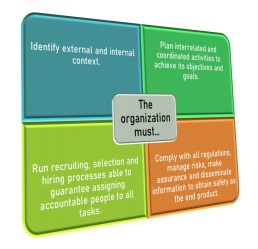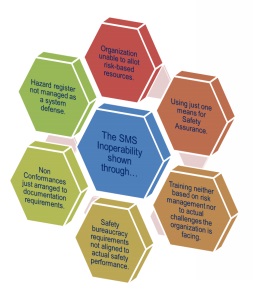Aviation is terribly unforgiving of any carelessness, incapacity or neglect is what Captain Alfred Gilmer Lamplugh stated approximately in 1930, and that gave us plain and fertile grounds to deem safety must be located within a system in the aviation business. The SMS is not a magic potion with the ability to free us from accidents or incidents despite our poor organizational performance and unwillingness to comply with the commitments expressed in the safety policy. Is not enough saying Safety First in our Safety Policy?
Obviously the answer is negative. Additionally, we must consider this as the backbone of our safety system: Not to mislead ourselves, our customers and shareholders by saying Safety is Top Priority in our companies, when we are not complying with regulations, we are not managing risks, and we are not running our business in a systematic process-based approach.
As a state, safety cannot be automatically attained by just proclaiming it in policies, standards and manuals. Safety is not an advertisement. Safety is not just a documented objective.
What’s safety then? We must recognize Safety is the end product of complying with regulations, managing risks, learning from accidents and incidents, understanding the consequences of the ethics (for better and worse), communicating news to our internal customers, as well as being honest and base our grounds on ethics in the relationships with our external customers.
SMS Must Run both Neat and Operational
It is quite clear and necessary organizations are dealing with a
management system when they first try to implement the ICAO’smandated SMS. So, its workframe must:

i) Plan.– Identify not only organizational objectives and goals, but the external and internal context (a SWOT analysis would be just fine).
ii) Do.– Everything that was planned must be executed taking into account all defenses and controls laid out.
iii) Check.– No management system would run appropriately without monitoring measures to check if organizations are making the way as planned.
iv) Act.– If any deviations are identified, loop runs again until the organization runs neatly, efficiently and operational.
“Everything that was planned must be executed taking into account all defenses and controls laid out”.
Culture, Decision Making and SMS
While according to Thomas Krause, Ph.D., “a culture that truly values ethical (and safe) behavior must be led by men and women committed to
principle for its own sake, not solely for the purpose of compliance”, Patrick Benton states that “ethics refers to values that are intrinsic in the person making the decision and that may or may not affect the outcome of the decision. These values include (but are not limited to) trust, a sense of right and wrong, concern for the welfare of others, responsibility for one’s actions, and adherence to one’s beliefs in the face of pressure to do otherwise”.
What are the keywords here? At least, keywords we want to discuss?
Decision Making.– Perception depending from senses and perspectives, comes first followed by cosmovision, culture and ethics. Here, changes in cost of production must be done, no matter what.
What’s the need? As long as changes in service production costs are performed to lower them, profits are possible, and a sensation of a proficient and efficient manager arises. We are talking here about accountability, which will be developed in the next issue of this newsletter.
What Safety Publication to Read?
“… the tragedy had systemic origins that transcended individuals, organization, time, and geography (…) its origins were in routine and taken-for-granted aspects of organizational life that created a way of seeing that was simultaneously a way of not seeing.”
Such quote was taken from our recommendation to read for this month, according to Diane Vaughan in her book “The Challenger Launch Decision: Risky Technology, Culture, and Deviance at NASA”, published by the University of Chicago Press in 1996.
Is the SMS a Management System?
The answer is affirmative. As such, we must face it like a Management System.
What’s the current status now? Let’s have a brief look at the definitions, stated by ICAO and ISO 9000:2015. “Set of interrelated or interacting elements of an organization to establish policies and objectives, and processes to achieve those objectives”.
Note 2 to entry: The management system elements establish the organization’s structure, roles and responsibilities, planning, operation, policies, practices, rules, beliefs, objectives and processes to achieve those objectives. ISO 9000:2015. Standard 3.5.3.
Meanwhile, ICAO’s Annex 19 states that the SMS is a “systematic approach to managing safety, including the necessary organizational structures, accountability, responsibilities, policies and procedures”.
What can be told about it? These initial statements and treatment ICAO gives the SMS turns into a gap with respect to the ISO’s definition of a Management System, which emphasizes in how organizations can achieve objectives (see Note 2 to entry to ISO 9000:2015. Standard 3.5.3). Yet, ICAO’s SMS Framework could represent the principle of a set of interrelated or interacting elements of an organization, but the reader is neither guided nor directed to imply such treatment of a management system for safety, unless the systematic approach methodology be clearly explained, so the application could be accurate, complete and effective.
The Role of the SMS

The answer might look like this: To manage the inherent risks of the operational non compliance with rules, regulations, standards and documented procedures.
That means risks resulting from operational non compliance must be reduced and controlled by aeronautical organizations.
It’s quite important for air operators to run an effective and efficient SMS, but this must be achieved on the basis of interactive compliance with regulations and standards.







